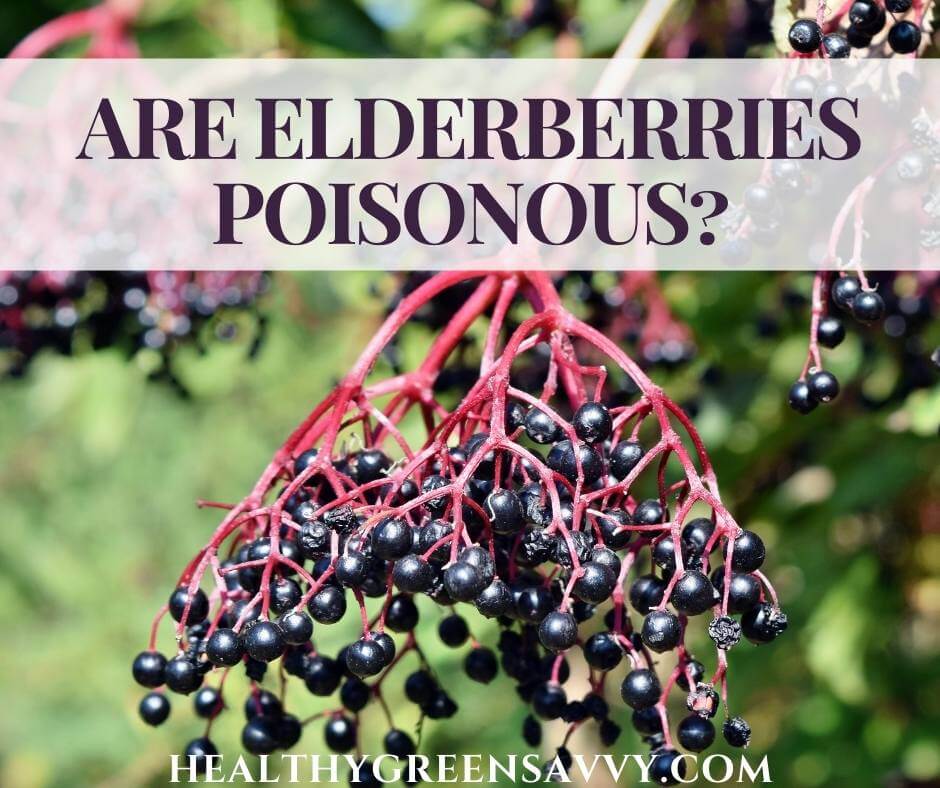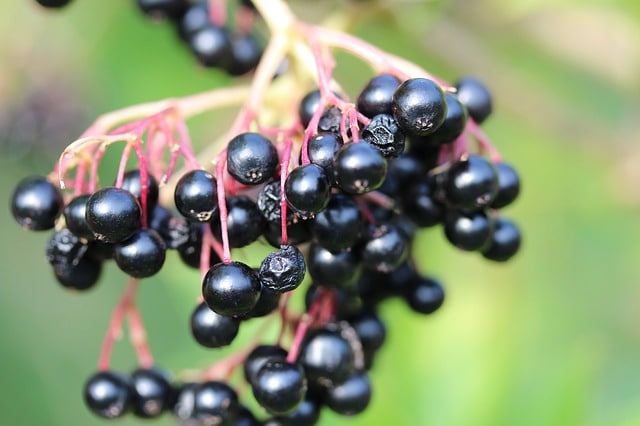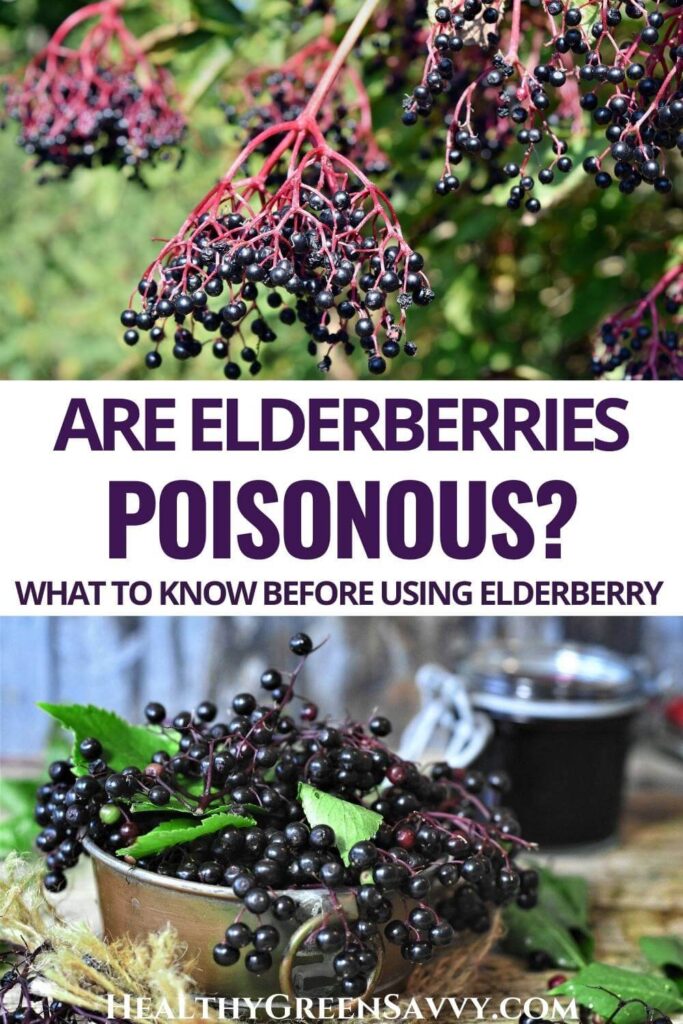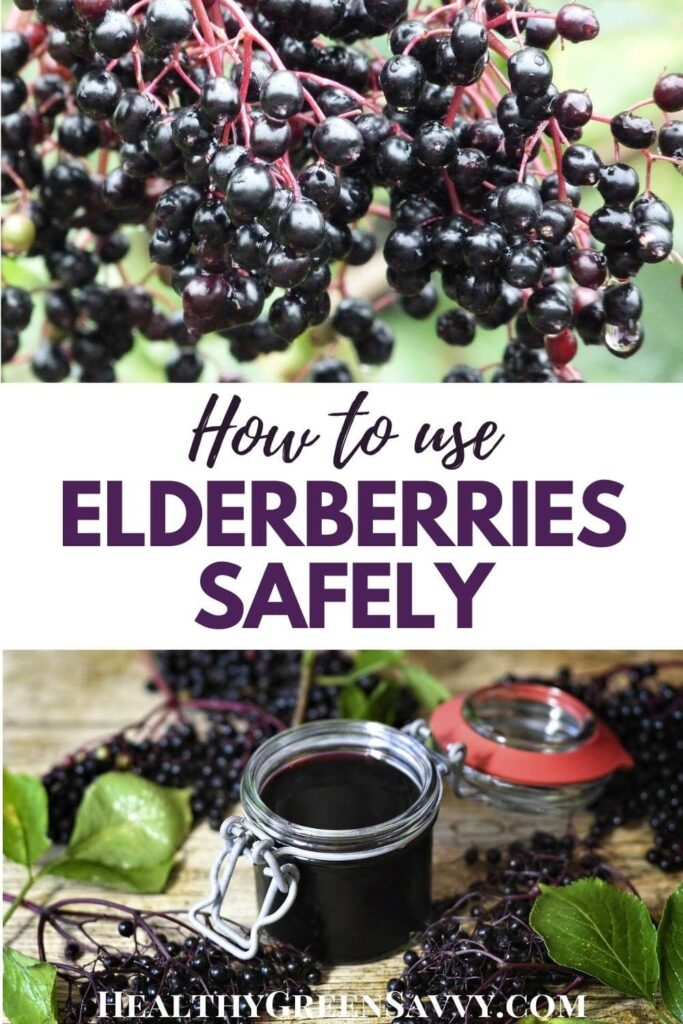Last Updated on September 23, 2024
You’ve probably heard that elderberries are a much-loved herbal remedy used by people around the world to fortify their immune systems and fight off viruses. So with all the documented benefits of elderberries, why do so many people wonder whether elderberries are poisonous?

Here at HealthyGreenSavvy we aim to clear up confusion wherever possible, like clarifying the differences between spruce vs fir vs pine, goldenrod vs ragweed, and catnip vs catmint. Let’s sort out why the question of whether it’s safe to eat elderberries continues to stalk the interwebs.
WHY DO PEOPLE THINK ELDERBERRIES ARE POISONOUS?
Of course, all those people taking elderberry syrup regularly aren’t poisoning themselves. But there are several reasons this confusion about the safety of elderberries persists. Let’s explore why so many people still think elderberries might not be safe to eat
1. ‘Poisonous’ Can Mean Different Things
Something poisonous can kill you, but it may also just make you ill. Most people assume ‘poisonous’ means deadly, but it can also mean that eating the substance will give you a bad belly ache. It depends on how poisonous that substance is.
Elderberries contain tiny amounts of compounds called cyanogenic glycosides as well as lectins and alkaloids, compounds that are found in many of the foods we eat every day. Lectins are what give some people trouble with beans, for instance, and there are small amounts cyanogenic glycosides in almonds and numerous other common foods we don’t worry about eating.
If we ate enough of these foods, theoretically they could kill us. But so could drinking too much water!
Another berry that confuses people often is honeysuckle, but in this case there are some very poisonous berries to be avoided. Lots of poisonous types grow wild and a few edible types (usually called haskap berry or honeyberry) are cultivated for food. Here’s what to know about poisonous vs edible honeysuckle berries if you’re curious.
The flowers of many of these plants are not only edible, but delicious, by the way. Here are some honeysuckle recipes using the blossoms if you want to try.
2. Some Elderberries Are More ‘Poisonous’ Than Others
The elderberries used for herbal remedies have much lower levels of these compounds than other varieties.
Red elderberry (Sambucus racemosa) has given many people bad belly aches, though Native Americans consumed red elderberries after lengthy and careful preparation, including removing all the seeds, which are high in cyanogenic glycosides. Here’s more on red elderberry.
Likewise, dwarf elderberry is used medicinally by some, though most foraging experts consider it poisonous and recommend avoiding it. A French maker of elderberry products I interviewed for my book told me dwarf elderberry tastes terrible as well.
The standard elderberry used in commercial production is the European elderberry, Sambucus nigra, which contains small amounts of cyanogenic glycosides in the fruit and larger amounts in other parts of the plant. When the berries are cooked and processed, the toxic compounds of concern are neutralized, and most people enjoy them without incident. (More on the small number of people who don’t below.)
The American elderberry, Sambucus canadensis, has been found to contain significantly smaller amounts of these compounds in all parts of the plant, and negligible amounts in the berry. These are the elderberries you’re most likely to come across growing wild in North America. They’re not yet used as much commercially, but they’re a growing slice of the market, and a favorite of foragers.
3. Some People are More Sensitive to Compounds in Elderberries, Especially Raw Elderberries
Those very sensitive to these compounds may get severe stomach upset from consuming raw elderberries (more likely with nigra than canadensis), and may not feel great after eating cooked berries, especially if they contain seeds.
People with sensitive stomachs should only consume elderberries cooked and may find that straining out the seeds helps them tolerate elderberries better.

4. Some Parts of Elderberry Plants are Higher in Poisonous Compounds than the Berries
Compounds in most elderberry bushes — the leaves, bark, branches, stems and roots — can make you very sick and in large enough quantities could be deadly.
The only documented case of elderberry poisoning was in 1983, when 11 people drank fresh-pressed elderberry juice made with leaves and branches of the blue elderberry, Sambucus mexicana. Leaves and branches contain far higher concentrations of alkaloids and glycosides than the berries. The people who drank this juice felt awful, but all recovered, according to the CDC report.
EATING ELDERBERRIES SAFELY
So now you understand that elderberries aren’t poisonous, and eating things made with ripe, cooked black elderberries is perfectly safe.
Ripe black elderberries, especially if they’re cooked and seeds are strained, are well tolerated by most people. We generally avoid unripe berries, which are higher in the compounds of concern.
Sensitive individuals may find that American elderberries cause less trouble than European ones, and many foragers nibble them raw without incident. They don’t taste that wonderful raw, though, so there’s not much reason to see how many you can consume before they make you feel bad.
Now that you know how not to poison yourself with elderberries, here are some excellent uses for elderberries. You can also make delicious homemade elderberry syrup or elderberry tea from fresh or dried elderberries. You can purchase pre-made elderberry syrup online or buy dried elderberries to make your own.
–> Want to know more about using elderberries safely and effectively? Pick up my free guide to using elderberries here.
Elderflowers are also edible (and delicious!) These fragrant blossoms can be used in all sorts of recipes. Sensitive folks will have an easier time with dried rather than fresh elderflowers in their elderflower tea and other elderflower recipes. Here’s more on elderflower benefits and uses.
WHERE TO GET ELDERBERRIES
1. Forage
If you like to forage, you can easily get loads of fresh elderberries growing wild, and if you’re in North America, you’ll likely be harvesting from plants lower in the compounds that can make people sick. Here’s what to know about elderberry identification.
If you’d like to learn more about foraging, the Herbal Academy’s online foraging course is on sale right now. The course teaches plant identification so you can feel more confident foraging wild edibles. They have an array of herbalism courses worth checking out, too!

2. Grow Your Own
I also highly recommend growing them in your garden, as they are beautiful, great for wildlife, and can manage with less than ideal soil and partial shade. Plus you can choose cultivars selected for superior flavor and size.
Here’s everything you need to know about growing elderberry, as well as some of the best elderberry varieties for home gardeners.
3. Buy
You can get dried elderberries in natural food stores and online. I recommend buying several one-pound bags when they’re on sale. They’re generally $20-25 a pound on Amazon. Starwest, and Etsy; I often get them for much less when there’s a sale at Vitacost, though they’re sometimes out of stock.
Note that sometimes purchased dried berries or flowers can contain a fair amount of stem material, so be sure to pick it out, especially if you’re sensitive to the compounds in elderberries that give some people trouble.
Pro tip: Get extra in early fall, before supplies run low. Dried elderberries can be hard to get in the winter, when we need them most. A one-pound bag will yield MANY pots of elderberry tea and batches of elderberry syrup!
Next time someone asks you, ‘Are elderberries poisonous?’ pour them some elderberry tea and explain that you’re not trying to kill them!
Curious about other tasty foods to forage? Here are some great places to start:
You can find loads more guides to identifying and foraging edible wild plants in the foraging section of this site.
Save this info on using elderberries safely for later!

Photo credits: Adam88xx, Frauke Feind, Hans Braxmeier, Madeleine Steinbach

Susannah is a proud garden geek and energy nerd who loves healthy food and natural remedies. Her work has appeared in Mother Earth Living, Ensia, Northern Gardener, Sierra, and on numerous websites. Her first book, Everything Elderberry, released in September 2020 and has been a #1 new release in holistic medicine, naturopathy, herb gardening, and other categories. Find out more and grab your copy here.


 Hi, I'm Susannah, a garden geek, energy nerd, and fan of healthy food and natural remedies. Need some simple, practical solutions for living healthier and greener? You've come to the right place! More about me and my green projects
Hi, I'm Susannah, a garden geek, energy nerd, and fan of healthy food and natural remedies. Need some simple, practical solutions for living healthier and greener? You've come to the right place! More about me and my green projects